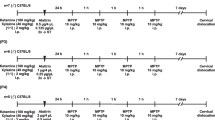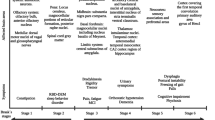Abstract
Rifampicin is an antibacterial drug which is highly effective in the treatment of tuberculosis and leprosy. It has been shown to exert antioxidative as well as anti-apoptotic effects. In this study, the neuroprotective effect of rifampicin was examined after 1-methyl-4-phenylpyridinium (MPP+)-induced dopaminergic cell death in vitro, and on the survival of retinal ganglion cells after optic nerve transection in vivo. Rifampicin administration significantly increased the number of surviving dopaminergic neurons after MPP+ intoxication as compared to control cultures. No cytotoxic effects were noted even at final rifampicin concentrations of 100 μM. In the rifampicin-treated group, retinal ganglion cell survival was significantly increased after axotomy as compared with vehicle-treated and phosphate-buffered saline-treated control animals. These results suggest that rifampicin is able to prevent neuronal degeneration in cell death paradigms involving oxidative stress and activation of apoptotic pathways. It may thus play a role in the future treatments of neurodegenerative disorders.



Similar content being viewed by others
References
Acocella G (1978) Clinical pharmacokinetics of rifampicin. Clin Pharmacokinet 3:108–127
Calleja C, Pascussi JM, Mani JC, Maurel P, Vilarem MJ (1998) The antibiotic rifampicin is a nonsteroidal ligand and activator of the human glucocorticoid receptor. Nat Med 4:92–96
Castagne V, Clarke PG (1996). Axotomy-induced retinal ganglion cell death in development: its time course and its dimunition by antioxidants. Proc R Soc Lond B Biol Sci 263:1193–1197
Eberhardt O, Schulz JB (2003) Apoptotic mechanisms and antiapoptotic therapy in the MPTP model of Parkinson’s disease. Toxicol Lett 4:135–151
Eschweiler GW, Bahr M (1993) Flunarizine enhances rat retinal ganglion cell survival after axotomy. J Neurol Sci 116:34–40
Gollapudi S, Jaidka S, Gupta S (2003) Molecular basis of rifampicin-induced inhibition of anti-CD95-induced apoptosis of peripheral blood T lymphocytes: the role of CD95 ligand and FLIPs. J Clin Immunol 23:11–22
Hal ED (1997) Antioxidant pharmacotherapy. In: Ginsberg M, Bogousslavsky J (eds) Cerebrovascular disease: pathophysiology, diagnosis and management. Blackwell Science, Malden
Isenmann S, Wahl C, Krajewski S, Reed JC, Bahr M (1997) Up-regulation of Bax protein in degenerating retinal ganglion cells precedes apoptotic cell death after optic nerve lesion in the rat. Eur J Neurosci 9:1763–1772
Karunakar N, Prabhakar MC, Krishna DR (2003) Determination of antioxidant activity of some drugs using high-pressure liquid chromatography. Arzneimittelforschung 53:254–259
Kilic E, Hermann DM, Isenmann S, Bahr M (2002) Effects of pinealectomy and melatonin on the retrograde degeneration of retinal ganglion cells in a novel model of intraorbital optic nerve transection in mice. J Pineal Res 32:106–111
Klocker N, Cellerino A, Bahr M (1998) Free radical scavenging and inhibition of nitric oxide synthase potentiates the neurotrophic effects of brain-derived neurotrophic factor on axotomized retinal ganglion cells in vivo. J Neurosci 18:1038–1046
Krieglstein K, Suter-Crazzolara C, Hotten G, Unsicker K (1995) Trophic and protective effects of growth/differentiation factor 5, a member of the transforming growth factor-beta superfamily, on midbrain dopaminergic neurons. J Neurosci Res 42:724–732
Lingor P, Unsicker K, Krieglstein K (2000) GDNF and NT-4 protect midbrain dopaminergic neurons from toxic damage by iron and nitric oxide. Exp Neurol 163:55–62
Mindermann T, Landolt H, Zimmerli W, Rajacic Z, Gratzl O (1993) Penetration of rifampicin into the brain tissue and cerebral extracellular space of rats. J Antimicrob Chemother 31:731–737
Namba Y, Kawatsu K, Izumi S, Ueki A, Ikeda K (1992) Neurofibrillary tangles and senile plaques in brain of elderly leprosy patients. Lancet 340:978
Przedborski S, Chen Q, Vila M, Giasson BI, Djaldatti R, Vukosavic S, Souza JM, Jackson-Lewis V, Lee VM, Ischiropoulos H (2001) Oxidative post-translational modifications of alpha-synuclein in the 1-methyl-4-phenyl-1,2,3,6-tetrahydropyridine (MPTP) mouse model of Parkinson’s disease. J Neurochem 76:637–640
Psarra AM, Bochaton-Piallat ML, Gabbiani G, Sekeris CE, Tsacopoulos M (2003) Mitochondrial localization of glucocortocoid receptor in glial (Muller) cells in the salamander retina. Glia 41:38–49
Tomiyama T, Shoji A, Kataoka K, Suwa Y, Asano S, Kaneko H, Endo N (1996) Inhibition of amyloid β protein aggregation and neurotoxicity by rifampicin. J Biol Chem 271:6839–6845
Wenzel A, Grimm C, Seeling MW, Jaissle G, Hafezi F, et al (2001) Prevention of photoreceptor apoptosis by activation of the glucocorticoid receptor. Invest Ophthalmol Vis Sci 42:1653–1659
World Health Organization (1988) WHO Expert Committee on leprosy, sixth report. Tech. Rep. Ser. 768, WHO, Geneva
Wu RM, Murphy DL, Chiueh CC (1996). Suppression of hydroxyl radical formation and protection of nigral neurons byl-deprenyl (selegiline). Ann N Y Acad Sci 15:379–390
Author information
Authors and Affiliations
Corresponding author
Rights and permissions
About this article
Cite this article
Kilic, Ü., Kilic, E., Lingor, P. et al. Rifampicin inhibits neurodegeneration in the optic nerve transection model in vivo and after 1-methyl-4-phenylpyridinium intoxication in vitro. Acta Neuropathol 108, 65–68 (2004). https://doi.org/10.1007/s00401-004-0867-6
Received:
Revised:
Accepted:
Published:
Issue Date:
DOI: https://doi.org/10.1007/s00401-004-0867-6




